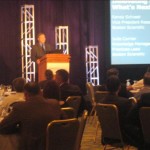Jun17
How Xerox Monetizes Non-Core Innovation
Point:
Monetize non-core innovation rather than pruning it.
Story:
Ursula Burns, CEO of Xerox, discussed innovation at her company in an interview at the World Innovation Forum June 9, 2010. She described initiatives to improve the return on innovation at Xerox’s research  centers such as PARC (Palo Alto Research Center). PARC’s ground-breaking inventions like the graphical user interface, ethernet, and postscript as inventions had a large impact on the world but didn’t contribute enough to Xerox’s bottom line. Let’s look at why that happened and what Xerox is doing now.
centers such as PARC (Palo Alto Research Center). PARC’s ground-breaking inventions like the graphical user interface, ethernet, and postscript as inventions had a large impact on the world but didn’t contribute enough to Xerox’s bottom line. Let’s look at why that happened and what Xerox is doing now.
Unpredictability lies at the core of the innovation process. Not only do innovators not know if an early-stage innovation will succeed or fail, they also can’t know all the possible applications or value latent in that innovation. Thus, it’s far too easy for an exciting innovation to stray outside the bounds of the company’s core competence.
At some level, reaping the greatest value from a research organization means allowing researchers the freedom to explore. Burns noted that innovators love working on interesting projects — it’s hard to stop them from doing it. Rather than fetter its folk, Xerox found three ways to give them freedom while still reaping the value of innovations that fall outside the company’s core.
First, Xerox expanded its definition of what is core to the company. Previously, Xerox defined itself as a copier company, looking for innovations in how to “reproduce images on paper.” That narrow definition meant that many of the early PARC inventions were not pursued. Since then, Xerox expanded to document management and is moving toward being a more general office information process company. Rather than fear the paperless office, Xerox wants to help customers implement the paperless office. Xerox’s recent acquisition of ACS positions Xerox in business process outsourcing — managing the non-paperless back office functions of customers and clients. The expanding vision of Xerox brings more innovations within the scope of the company’s core. For example, the company now has a use for its smart document innovations that can automate some of the labor-intensive discovery process in legal proceedings.
Second, rather than discarding innovations that don’t fit inside the company, Xerox now looks for partners or buyers for whom the innovation does provide value. For example, some of Xerox’s innovations in precision printing can apply to the low-cost manufacturing of solar panels. Xerox isn’t going to become a solar panel manufacturer — that’s too far outside its core. But rather than dismissing the innovation, Xerox partnered with a West Coast firm to incubate a new company that can leverage the value of those innovations.
Third, outside companies can now hire PARC and its portfolio of specialists to tackle tough R&D problems. CEO Burns said that most PARC’s activities remain focused on Xerox, but the option to sell non-core innovations lets the company maintain the innovative culture of PARC while monetizing its researchers’ outputs. In short, Xerox is expanding how it leverages the fruits of innovation rather than pruning the innovation funnel.
Action
- When evaluating innovation projects, don’t immediately rule out ideas outside the company’s current strategies, customers, or core
- Instead, also ask if an innovation might be more valuable to a non-competing outsider
- Find complementary partners who can license or buy non-core innovations or innovation expertise to reap the greatest total value from the innovation process.
- Allow innovators enough freedom to enable breakthroughs.
- Expand or reenvision the core of the company to leverage innovation.











